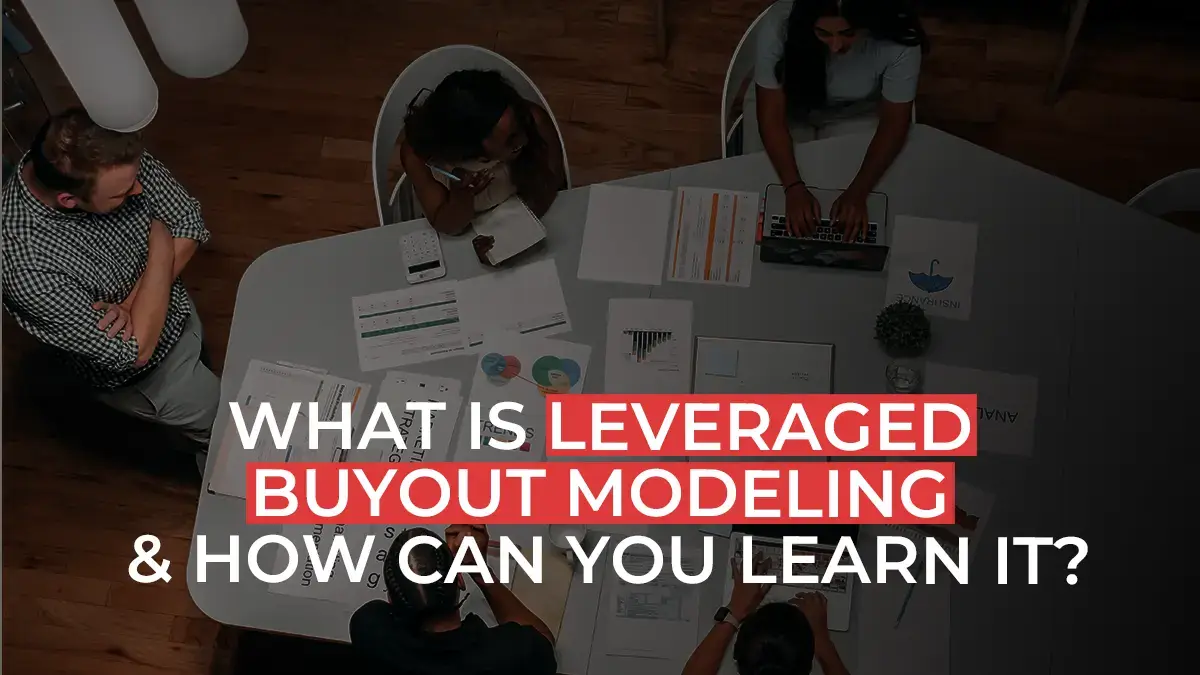What is Leveraged Buyout Modeling & how can you learn it?

Here's What We've Covered!
- Historical Overview and Evolution of Leveraged Buyout Modeling
- What are Leveraged Buyouts (LBOs)
- Understanding Leveraged Buyouts
- Understanding Leveraged Buyout Modeling
- Benefits of Learning Leveraged Buyout Modeling
- Tips for Mastering Leveraged Buyout Modeling
- How to Learn Leveraged Buyout Modeling
- FAQs
- Q: What are the main differences between an LBO and a traditional acquisition?
- Q: How do you determine the appropriate level of leverage in an LBO?
- Q: What are the key financial metrics used to evaluate the feasibility of an LBO deal?
- Q: How does macroeconomic uncertainty affect LBO modeling and deal structuring?
- Q: Can you provide some insights into the exit strategies commonly employed in LBO transactions?
Learning about Leveraged Buyouts (LBOs) is important for finance students because it teaches them how companies are bought using debt. This skill is useful for jobs in corporate finance, investment banking, and private equity. Knowing LBOs helps students understand company value, how to use debt smartly, and how to increase returns. This knowledge can lead to better job opportunities and success in the finance field.
Now, let’s learn more about LBOs.
Historical Overview and Evolution of Leveraged Buyout Modeling
Leveraged Buyouts (LBOs) have a fascinating history that shows how they’ve changed over time.
Back in the 1960s and 1970s, LBOs weren’t as common. They started gaining popularity in the 1980s, known as the “decade of the LBO.” During this time, big companies used LBOs to buy other companies, sometimes even if those companies didn’t want to be bought! This made LBOs kind of controversial.
In the 1990s, LBOs continued to grow, but they changed a bit. Instead of being hostile takeovers, where one company forces another to sell, they became more about buying companies that were struggling and trying to turn them around.
In the 2000s and beyond, LBOs became more regulated. People realized they could be risky and lead to big problems if they went wrong. So, rules were put in place to make sure they were done carefully and didn’t hurt the companies involved or the economy.
Today, LBOs are still a big part of the finance world. They’re used for all kinds of reasons, from buying big companies to helping smaller ones grow. While they’ve had their ups and downs over the years, LBOs continue to be an important tool in the world of finance.
What are Leveraged Buyouts (LBOs)
A leveraged buyout (LBO) is when one company buys another company using a lot of borrowed money (like loans or bonds). The company being bought usually has its own assets used as security for these loans, along with the assets of the company doing the buying.
In an LBO, the typical ratio is about 90% debt (borrowed money) to 10% equity (money from the buyers themselves). Because of this high amount of debt, the bonds issued are often not of high quality and are called junk bonds.
LBOs are often seen as aggressive and unfriendly because the company being bought usually doesn’t agree to the buyout. It’s ironic because the target company’s own assets, which show its success, are used by the buying company as collateral to get the loans needed for the buyout.
LBOs are done for three main reasons:
- To take a public company private.
- To sell a part of an existing business.
- To transfer ownership of private property, like in small business sales.
In all these cases, it’s important that the company being bought is profitable and growing.
LBOs became notorious in the 1980s when many high-profile buyouts led to the bankruptcy of the acquired companies. This was because the debt was almost 100%, and the interest payments were so high that the companies couldn’t keep up with them using their operating cash flows.
Leveraged Buyout Modeling Example
Here’s a big example of a Leveraged Buyout (LBO): In 2006, a group of companies, including Kohlberg Kravis Roberts & Co. (KKR), Bain & Co., and Merrill Lynch, bought Hospital Corp. of America (HCA) for a whopping $33 billion. That’s a huge amount of money!
After the financial crisis in 2008, there weren’t as many big LBOs. But during the COVID-19 pandemic in 2021, they started to pick up again. One big one was when a bunch of investors, led by Blackstone Group, bought Medline, a company that makes medical equipment, for $34 billion. That’s another massive deal in the world of finance!
Also Read – 8 Types of Financial Models & Their Applications
How Does a Leveraged Buyout Work?
Imagine one company wants to buy another company. Instead of using its own money, it borrows a huge amount of money to pay for the purchase. This borrowed money is usually in the form of bonds.
Here’s the tricky part: The assets of the company being bought can be used as security for the loans. This means if the buying company can’t pay back the loans, the assets of the bought company could be taken as payment.
LBOs can seem pretty aggressive or unfriendly, but they’ve actually become more common again in recent years, especially in the early 2020s.
Why Do Leveraged Buyouts Happen?
Leveraged buyouts (LBOs) happen for a few reasons. One is to take a public company private, meaning it’s no longer traded on the stock market. Another reason is to sell part of a business, like if a company wants to focus on its main operations and sell off a division. Sometimes, LBOs are used when someone wants to buy a small business from its current owner.
The cool thing about LBOs is that the company doing the buying doesn’t need to use a lot of its own money. Instead, it borrows a big chunk of the money needed, which lets it buy a much bigger company than it could otherwise.
Which Companies Are Attractive for Leveraged Buyout Modeling?
Private equity firms usually go for companies that are already well-established and making good money. These companies are often in industries that have been around for a while, rather than new or risky ones. The ones that are the most attractive for leveraged buyouts have steady income, products or services that people know and like, good leadership, and plans for how the new owner can make even more money when they eventually sell the company.
Importance and Significance of Leveraged Buyout Modeling in Finance
Leveraged Buyouts (LBOs) are like big money games in finance. Imagine one person using a lot of borrowed money to buy a cool toy from another person. That’s what happens in an LBO but with big companies instead of toys!
Here’s why LBOs are important:
- Big Business Moves: LBOs are like big chess moves in the business world. Companies use them to buy other companies or take them out of the public eye.
- Making Money Magic: They’re like magic tricks with money. Companies borrow a lot of money to buy another company, hoping to make even more money later.
- High Risk, High Reward: LBOs are exciting because they’re risky. Sometimes they make lots of money, but other times they don’t work out well. It’s like a big adventure in the world of finance!
So, LBOs are a big deal because they’re all about making bold moves, playing with big money, and taking risks to hopefully come out on top!
Also Read – Top 7 Skills That Make You An Expert In Finance
Understanding Leveraged Buyouts
-
High Debt-to-Equity Ratio in LBOs
In a leveraged buyout (LBO), a company buys another company using a lot of borrowed money and a little bit of its own money. This means they have a high debt-to-equity ratio, which usually means they borrow 90% of the money they need and only use 10% of their own money.
Example: Imagine you want to buy a toy store for Rs. 100. Instead of using all your own money, you borrow Rs. 90 from the bank and only use Rs. 10 of your own money. This means you have a high debt-to-equity ratio of 9:1.
-
Characteristics of LBO Bonds
When companies do leveraged buyouts (LBOs), they often need to borrow a lot of money. However because they borrow so much, the bonds they issue are usually not considered very safe for investors. These bonds are often called “junk bonds” because they are riskier than other types of bonds.
-
Purpose and Objectives of LBOs
Leveraged buyouts (LBOs) happen for different reasons. Sometimes, a company wants to become private instead of being a public company. Other times, they might want to sell part of their business. And sometimes, people just want to change who owns a small business.
-
Taking a Public Company, a Private
When a company wants to become private, it means they don’t want their shares to be bought and sold on the stock market anymore. They want to be owned by just a few people or by another company.
-
Spinning off Business Segments
Sometimes, a company might want to sell part of its business. This could be because that part of the business is not doing well, or because they want to focus on a different part of the business.
-
Transferring Private Property
Sometimes, people want to sell their business or give it to someone else. This is called transferring private property. It could be a small business, like a family-owned store, or a bigger business.
Understanding Leveraged Buyout Modeling
LBO Modeling, used to evaluate leveraged buyout transactions, involves several key steps:
- Assumptions: Establish key assumptions like financing structure, business metrics, and exit scenarios to drive the model’s flexibility.
- Financial Statements: Construct interconnected income statements, balance sheets, and cash flow statements based on historical data, along with supporting schedules.
- Transaction Balance Sheet: Create a balance sheet post-acquisition to show the adjusted capital structure of the company.
- Debt and Interest Schedules: Develop detailed schedules outlining repayment obligations for various debt instruments used in the transaction.
- Credit Metrics: Calculate key metrics like debt-to-EBITDA ratio and interest coverage ratio to assess the company’s financial health post-LBO.
- DCF and IRR: Use discounted cash flow analysis to estimate future cash flows and calculate the internal rate of return (IRR) and net present value (NPV).
- Sensitivity Analysis: Conduct sensitivity analysis to assess the impact of variable changes on investment attractiveness and identify potential risks and opportunities.
Also Read – Top 6 Financial Modeling Jobs For Freshers
Benefits of Learning Leveraged Buyout Modeling
Learning about LBO modeling can offer you many advantages that can help you in the future.
Let’s explore some of the key benefits:
Career Opportunities in Finance
Understanding LBO modeling can open up various career paths in finance. You could work in big financial institutions like banks, investment firms, or even in the finance departments of large companies. With this knowledge, you become valuable to employers looking for people who can analyze financial data and make smart decisions.
Enhanced Financial Analysis Skills
LBO modeling teaches you how to analyze financial information effectively. You’ll learn how to interpret financial statements, which are reports that show a company’s financial health. By mastering these skills, you’ll be able to understand how businesses operate financially and make informed decisions based on data.
Understanding Complex Financial Structures
Companies often use complex financial strategies to manage their money. Learning about LBO modeling helps you understand these intricate financial structures. You’ll discover how companies buy and sell each other, how they use loans and debts to grow, and how they manage risks. This knowledge gives you a deeper understanding of how the financial world works.
Tips for Mastering Leveraged Buyout Modeling
Mastering LBO Modeling can be challenging but rewarding. Here are some helpful tips to enhance your skills in LBO modeling:
- Practice Regularly with Real-world Examples: The best way to improve your LBO modeling skills is through practice. Work on real-world examples and case studies to gain hands-on experience. This will help you familiarize yourself with different scenarios and refine your modeling techniques.
- Stay Updated with Industry Trends and Best Practices: The finance industry is constantly evolving, so it’s essential to stay updated with the latest trends and best practices in LBO modeling. Follow industry publications, attend webinars, and participate in workshops to stay abreast of developments in the field.
- Seek Feedback and Guidance from Peers and Professionals: Don’t hesitate to seek feedback and guidance from peers and professionals in the field. Collaborate with colleagues on modeling projects, join online forums and communities, and reach out to mentors for advice. Constructive feedback can help you identify areas for improvement and refine your modeling skills further.
How to Learn Leveraged Buyout Modeling
If you’re interested in mastering LBO Modeling, IMS Proschool’s Financial Modeling Course is an excellent place to start. Here’s how you can learn LBO Modeling through this course:
- IMS Proschool’s Financial Modeling Course: When you enroll in IMS Proschool’s Financial Modeling Course, you gain access to expert instruction and comprehensive learning materials. The course covers all aspects of financial modeling, including LBO modeling, through interactive sessions and hands-on exercises.
- Self-Study Resources: Along with classroom sessions, IMS Proschool provides self-study resources such as study materials, video tutorials, and practice exercises. These resources allow you to reinforce your understanding of LBO modeling concepts at your own pace.
- Practice Exercises: Practice is key to mastering LBO modeling. IMS Proschool offers practice exercises and case studies that simulate real-world scenarios, allowing you to apply your knowledge and refine your modeling skills.
- Networking and Mentorship Opportunities: IMS Proschool provides networking opportunities with industry professionals and mentors who can offer guidance and insights into LBO modeling. Engage with peers and mentors to exchange ideas, seek advice, and enhance your learning experience.
FAQs
Q: What are the main differences between an LBO and a traditional acquisition?
A: In a traditional acquisition, the acquiring company typically uses its own funds or a combination of its own funds and debt to purchase another company. In contrast, a leveraged buyout (LBO) involves acquiring a company primarily using borrowed funds, with the assets of the acquired company often serving as collateral for the debt. LBOs typically result in higher leverage ratios and require more aggressive financial structuring than traditional acquisitions.
Q: How do you determine the appropriate level of leverage in an LBO?
A: The appropriate level of leverage in an LBO depends on various factors, including the target company’s cash flow generation, asset base, growth prospects, and industry dynamics. Generally, leverage is determined based on the target company’s ability to service its debt obligations, which is assessed using financial metrics such as debt-to-EBITDA ratio, interest coverage ratio, and debt service coverage ratio. The goal is to strike a balance between maximizing returns for investors and maintaining financial stability for the acquired company.
Q: What are the key financial metrics used to evaluate the feasibility of an LBO deal?
A: Several key financial metrics are used to evaluate the feasibility of an LBO deal, including internal rate of return (IRR), net present value (NPV), cash-on-cash return, and return on invested capital (ROIC). These metrics help assess the potential returns and risks associated with the transaction, taking into account factors such as financing costs, operating performance, and exit strategies.
Q: How does macroeconomic uncertainty affect LBO modeling and deal structuring?
A: Macroeconomic uncertainty can significantly impact LBO modeling and deal structuring by affecting factors such as interest rates, market conditions, and industry trends. Uncertainty may lead to higher financing costs, increased risk premiums, and greater volatility in cash flows, which can impact the feasibility and profitability of LBO transactions. To mitigate these risks, LBO models often incorporate sensitivity analyses and scenario planning to assess the impact of different economic scenarios on deal outcomes.
Q: Can you provide some insights into the exit strategies commonly employed in LBO transactions?
A: Common exit strategies in LBO transactions include initial public offerings (IPOs), strategic sales, and recapitalizations. An IPO involves taking the acquired company public, allowing investors to sell their shares on the stock market. Strategic sales involve selling the company to another strategic buyer, often at a premium valuation. Recapitalizations involve refinancing the company’s debt or selling a portion of the company to generate liquidity for investors while retaining ownership. The choice of exit strategy depends on factors such as market conditions, investor objectives, and the company’s growth prospects.
Resent Post
>
Best Study Abroad Courses for Commerce Graduates
>
Emerging commerce career options in India (2026): From CA to Data Analyst
>
ACCA Opportunities You Didn’t Know About – Think Beyond Audit!
>
Which Courses After 12th Commerce With High Salary Are in Demand Worldwide?
>
How to Find ACCA Jobs Online After Qualifying: Real Portals, Tips & Career Guidance
Follow Us For All Updates!



